|
ST KILDA was, for1 the
first time, officially enumerated in 1851. The report of the census of
that year refers to a tradition that the population of the island had
been nearly stationary for two hundred years, sometimes falling below,
and sometimes exceeding, one hundred persons. Martin, however, informs
us that at the time of his visit in 1697, the inhabitants amounted to
about 180; but twenty-seven years afterwards, as already stated, a
contagious distemper, believed to have been smallpox, swept away the
greater part of the population. Since that date—that is, for a period of
rather more than 150 years—the number of the islanders has not very
materially fluctuated, .ranging from a maximum of no to a minimum of 71.
During the first half of the eighteenth century, the diminution of the
population was very marked, falling, as it did, to 88—38 males and 50
females—at the time of Macaulay’s visit in 1758. Thirty-seven years
later (1795), the number of the inhabitants was almost precisely the
same; but from that date it gradually rose till it reached 110—48 males
and 62 females—at the census of 1851; while, during the last twenty-six
years, the movement has been in the opposite direction. For upwards of a
hundred years, the average population of the island has been, as nearly
as possible, 93 souls. The number of inhabitants at the several dates
already referred to, and also at various other periods since the middle
of last century, is set forth in the following table, males and females
being separately stated, wherever it was possible to distinguish them :—
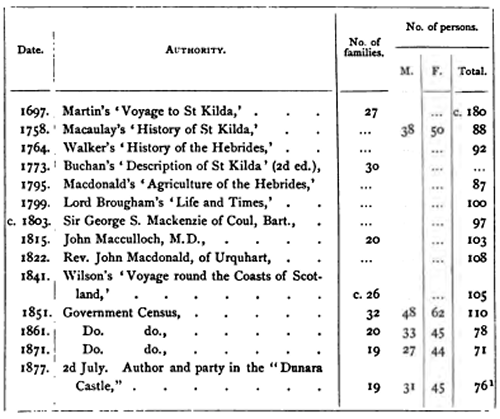
It appears from a
statement in the ‘Gazetteer of Scotland,’ that the first epidemic of
cholera (1832-33) was fatal in this remote region; but I have been
unable to find any definite information on the subject Any consequent
diminution of population that may have occurred appears to have been
very nearly made up a few years' afterwards. It ought to be borne in
mind that 36 of the inhabitants of St Kilda emigrated to Australia in
the year 1856; and accordingly, but for that circumstance, the natural
increase of the population in 1861 would have been 4 (that is, 114
instead of 78), on the assumption that all the emigrants survived to
that date. It appears, however, that several of them died on the
passage, and others after their arrival in the colony. About fifteen
years ago, only 13 of the 36 survived, and appeared to be doing well, as
they sent occasional remittances to their relatives in St Kilda. The
same decrease in the population between the censuses of 1861 and 1871 is
fully accounted for by the eight deaths by drowning which occurred in
the spring of 1863. Had all the deceased survived till the summer of
1871—and the oldest of the party was only 46—the population at that date
would have been almost exactly the same as ten years previously.
Notwithstanding their precarious mode of life and the hardships which
they are called upon to endure, it must not be supposed that the
inhabitants of St Kilda are not strongly attached to their island home.
“The very reverse of this,” says Mr Wilson, “may be inferred from the
few examples of their migrating to foreign countries, or even settling
in other Scottish islands, or on the mainland”—the devotion of the St
Kildans to their native shores thus forming a confirmation of the
sentiment implied in the sarcastic lines of one of the most
distinguished travellers in the Western Islands:—
“For who could leave,
unbribed, Hibernia’s land,
Or change the rocks of Scotland for the Strand?”
With regard to the
supposed capacity of the island in respect to population, Macaulay
ventures to affirm that, “if under proper regulations, it might easily
support 300 souls;” while an embryo Lord Chancellor, some forty years
later, indicated as his opinion that “with crops, cattle, and the vast
resources of sea-fowl, eggs, and fish, St Kilda is capable of supporting
a population of 1500 souls with ease.” If even the former of these
calculations may be regarded as approximately correct, the prospects of
the present inhabitants cannot be regarded as particularly gloomy. There
are two other Scottish islands which, in respect to magnitude,
geographical position, and general characteristics, bear a very
considerable resemblance to St Kilda—namely, Fair Isle and Foula, both
in the county of Shetland. The population of the former fell from 380 to
226 in the ten years ending 1871, in consequence of the removal of a
large number of the inhabitants under the auspices of the Board of
Supervision for the Relief of the Poor; while that of Foula increased
from 233 to 257 during the same period. The present population of Fair
Isle is 187, and that of Foula about 240.
The annexed table
exhibits a comparative statement of the surnames of the inhabitants of
St Kilda in 1841, and at the three subsequent decennial periods, under
the twofold classification of families and persons. The particulars
pertaining to 1841 are derived from Mr Wilson’s work :—
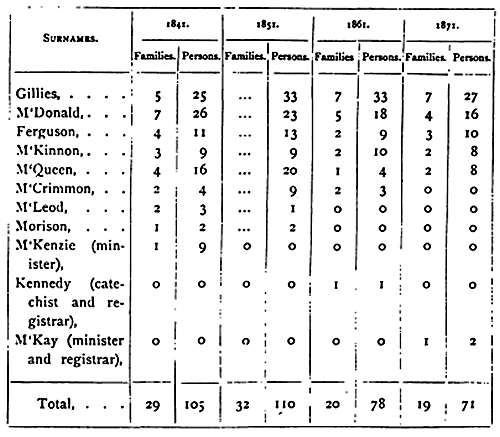
It will be observed that,
in 1871, only five surnames prevailed among the native population —
viz., Gillies, M'Donald, Ferguson, M'Kinnon, and M'Queen—M'Leod and
Morison having disappeared before 1861, and M'Crimmon before the last
official census. The M'Crimmons were the hereditary pipers of the
M'Leods, and, according to Lane Buchanan, held their lands in Skye from
Macleod of Macleod “for attending the chiefs person and family.’’ Among
the last of the race in St Kilda was Euphemia M'Crimmon, some of whose
stories (sgeulachdan) will be afterwards referred to. In 1871, the
prevailing Christian names among the males were John, Neil, Donald, and
Finlay; and among the females, Catherine, Rachel, Anne, and Mary. In
many cases, for the sake of distinction, a characteristic epithet is
added to the Christian name, after the manner of the “tee-names” of the
fishermen of Banff and Moray—e.g., Donull Og, or young Donald; Callum
Beag, or little Malcolm.
Mr Wilson says that “in
addition to whatever slight knowledge a few of them may possess of
certain handicrafts, the whole of the male sex who have attained to and
have not passed the prime of life, are what we may call practical
ornithologists, or cragsmen.” At the census of 1851, while eight of the
softer sex were described as “weaveresses in wool,” all the men were
designed “farmers and bird-catchers,” each farmer then occupying about
three acres of land. In 1861, a few of the females were described as
“cottars” or “servants”—the males being designed as follows :—
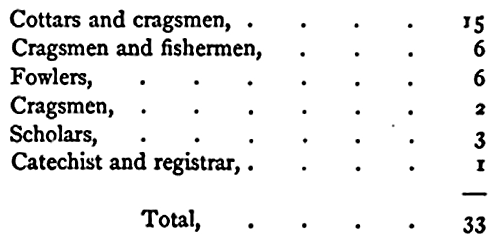
Accordingly, at that
date, it would appear that 29 of the 33 male inhabitants either
partially or exclusively followed the avocation of fowling.
In 1871, the occupations
were thus specified:—
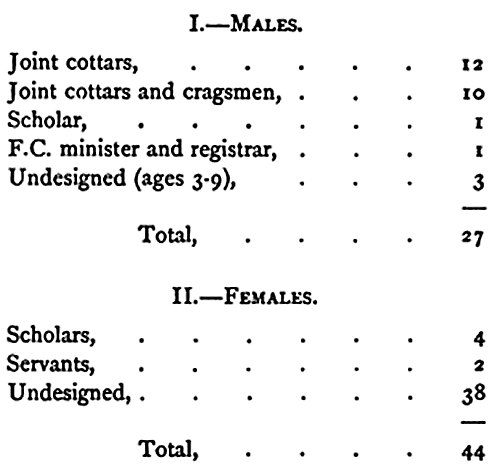
Martin states that “the
women have their assemblies in the village, where they discourse of
their affairs, but in the meantime employing their distaff and spinning,
in order to make their blankets.” The wool of the St Kilda sheep is very
fine, and excellent stockings are knitted by the females—soft and
somewhat similar to those made in Shetland. The women, however, who spin
the yarn, have no idea of fine work. Some of the men are good weavers;
and the cloth which they produce resembles that which is manufactured in
Harris, now so well known on the mainland through the philanthropic
efforts of Mrs Thomas. Each of the adult males acts as his own tailor
and shoemaker; and in every house there is a loom, also a spinning-wheel
and a large pot in which the yarn is dyed. “Mr Mantilini” is a familiar
character in St Kilda—the dresses of the women, as already mentioned,
being made by the men. Macaulay refers to the successful tanning of
leather with the root of tormentil, which, as already stated, is also
employed for dyeing purposes. “The St Kildans,” he says, “lay the
leather, when sufficiently prepared, in the warm infusion of this bark
for two nights, and afterwards keep it in the hollow of a rock, which is
under water at every full sea, with some of this root pounded about it,
until it is sufficiently tanned.” Forty years ago, it would appear that
the St Kildans manufactured earthen pots, of clay brought from the Long
Island, which they used for boiling milk.
Both men and women are
extremely industrious, and the assertions that have been made in some
quarters relative to their lazy habits appear to be utterly untrue. Mr
Sands alludes to the activity which prevailed during his last sojourn in
the island, towards the end of the year, in the way of spinning and
weaving—both sexes working from dawn of day till an hour or two after
midnight. Their assiduity quite astonished him. “The men vary their
sedentary occupation,” he says, “by going to fish when the weather
permits. In spring they scale the crags, and visit the adjacent islands
for eggs and birds, and cultivate their plots of ground. ... In summer
they fish for ling, which they cure and sell to the factor. Abqut the
end of July they require to be on the alert to catch the young fulmars,
before they are quite ready to take wing; and after their perilous
labours during the day, they are often obliged to sit up all night to
pluck the feathers. Then comes the season to knock the young solan geese
on the head,—and so on.” His account of the industry and activity of the
women, which is fully confirmed by Mrs M'Vean, is even more striking—the
manner in which they carry heavy loads of turf from every corner of the
island; the powerful aid which they render in dragging boats on their
arrival over the rocks; their milking, cheesemaking, and herding in all
states of the weather; their washing, spinning, and occasionally dyeing
of wool; their alertness in knitting stockings while tending the flocks
or when engaged in conversation; their snaring of puffins and plucking
the feathers; their help in tilling the land; and their grinding the
corn in hand-mills, after it has been thrashed with a flail, and
scorched in a pot or basket containing hot stones.
Notwithstanding the
prohibitory statute of Alexander III. in 1284, the quern or bra, though
much disused since the erection of country mills, is still pretty common
in some parts of Lewis and Harris, as well as in St Kilda, where it is
to be found in every cottage. It consists of two circular stones of
granite, from 15 to 18 inches in diameter, and about 4 inches thick,
laid flat upon each other. In the centre of the lower stone, which has a
hollow of some 5 inches in depth, there is an iron pivot on which the
upper stone, which is flat, is turned by means of a wooden handle. The
grain is dropped into a round hole in the centre of the upper stone,
finds its way between the two stones as the upper one is kept revolving,
and is supposed to be sufficiently ground when it comes out at the edge
between the stones. Mrs M‘Vean mentions that in her infancy the practice
in St Kilda was to place the quern on a sheep-skin, in the centre of the
floor, while two women, in accordance with the language of Scripture,
sat cross-legged on each side—one feeding the mill with grain, while the
other turned the handle with great rapidity. In referring to the same
process, Mr Sands describes the present female islanders as working
“like furies”! When Pennant wrote (1772), the quern was made on the
mainland, and cost about fourteen shillings. In alluding to the
tediousness of the process, he states that it occupied two pairs of
hands four hours to grind a single bushel of corn. He gives a pictorial
illustration of hand-mill grinding, and also of the process of cloth-waulking,
at both of which the usual custom was for the women to sing “slow and
melancholy ” tunes.
Mr Macdiarmid refers to
the well-built walls which surround the patches of cultivated ground, as
an indication of the masonic skill of the males. They possess axes and
hammers, and in one house he saw a large box of joiner’s tools. “They
are rather scarce of nails,” he adds, “which are always of use to them
in the case of accidents to their boats.”
Incidental reference has
already been made to the capabilities of St Kilda as a fishing station,
and several writers have noticed the disregard, on the part of the
islanders, of that important source of food and emolument “The neglect
of fishing,” says Macculloch, “proceeds from the wealth of the
inhabitants. They possess already as much food as they can consume, and
are under no temptation to augment it by another perilous and laborious
employment added to that to which they seem to have a hereditary
attachment; while their distance from a market, and the absence of
commercial habits, prevent them from undertaking a fishery for the
purpose of foreign sale. Yet the coast abounds in cod and ling, and may
perhaps hereafter prove a source of increased population ; if not of a
greater disposable produce, and consequent increase of rent to the
proprietor.” At the time of the doctor’s visit, the islanders possessed
only two boats, one of which was not serviceable, in consequence of its
having been allowed to go to decay for want of some trifling repairs. A
few years later, Dr Macdonald refers in one of his journals to the
abundance of fish in the immediate neighbourhood of St Kilda, and to the
disinclination of the inhabitants to secure the treasures of the deep.
Martin gives a curious account of the solitary boat, sixteen cubits in
length, which the islanders possessed at the end of the seventeenth
century. It was divided into apartments proportioned to their lands and
rocks; “every individual having his space distinguished to an
hair’s-breadth, which his neighbour cannot encroach so much as to lay an
egg upon it.” Mr Maclean describes the sail of the Lair-dhonn (or brown
mare), the designation of the St Kilda boat at the time of his visit in
1838. “It is made up,” he says, “of twenty-one patches of varied sizes
and shades, like what you would have fancied Joseph’s coat to have been,
and of coarse plaiding, the contribution of twenty-one partners, in
proportion to their share of land and rocks severally. The reefs are as
varied as the sail, made of old garters or woollen ropes.” An anonymous
visitor to St Kilda in August 1875, in a relative contribution to the ‘
Scotsman ’ newspaper, stated that there were then no fewer than eight
boats upon the island, but that the fishing seemed to be carried on “in
a kind of scrambling way.” Mr Sands, on the other hand, states that two
boats, with crews of eight and nine men respectively, went to sea almost
every night during the time he resided on the island, to fish for ling
with long lines. “Each boat would return in the morning, with perhaps,
on an average, about thirty-five ling and a few cod, besides other
fish,” such as lithe, halibut, black-mouths, skate, and conger-eels. He
also mentions that, in the July evenings, a number of elderly men were
in the habit of angling for mullet from the top of the crags near the
village. Mr Macdiarmid found four boats on the island in May 1877, two
of which had been recently presented to the islanders by casual
visitors. Although very good of their kind, he does not consider them
sufficiently strong to withstand the rough usage of being hauled over
the rocks at landing. He states that, on the recommendation of Captain
Digby of the “Jackal,” Government intends to send another boat
forthwith, and suggests that the most judicious course would have been
for the authorities to have ordered a boat to be specially built at
Stornoway, on the model of the ordinary herring-boats of that seaport He
also refers to the important question of a suitable landing-place, in
which Captain Otter took a deep interest, the continued want of which is
the source of so much inconvenience and danger. In his ‘ Sailing
Directions for the Hebrides,’ Captain Otter states that a very fair
landing-place was actually constructed at the north edge of the nearly
vertical rock below the manse. The large boulders when blasted were
cleared away to some distance, and a small breast-work erected; but, in
the course of two years, the drawback of the winter swells rolled back
the stones and destroyed it It appears that the Captain intended to have
cleared away the rock, and then to have made a cutting of about 40 or 50
yards into the bank to the right of the minister’s house, with the view
of letting the sea run in at high water. Mr Macdiarmid considers that
some such project might be carried out at a comparatively small cost,
and judiciously suggests that any public fund which may hereafter be
raised on behalf .of the St Kildans could not be better applied than to
the construction of a proper landing-place. The islanders are known to
be very expert in the management of rowing-boats, but inexperienced in
the use of sails, as is believed to have been indicated at the loss of
the “ Dargavel” in 1863. Judging, however, from their unequalled daring
as cragsmen, to which reference will be made in the following chapter,
it may fairly be conjectured that, with proper training, they would
prove themselves to be intrepid and skilful sailors.
With regard to the civil,
or conjugal condition of the St Kildans, it appears from the report on
the census of 1861, that, at that date, the island contained 13 married
couples, 1 widower, and 4 widows; while there were 8 bachelors and 9
spinsters between the ages of twenty and forty-six. In 1871, however,
the proportions of the latter were materially altered—the spinsters
between twenty and forty-six then amounting to no fewer than 14, and the
bachelors of the same age to only 3. The condition and ages of the
entire population at the last census (1871) are exhibited in the two
following tables, from the first of which it will be observed that the
number of unmarried and widowed females was then 29, while the males in
the same conditions amounted to only 12 :—
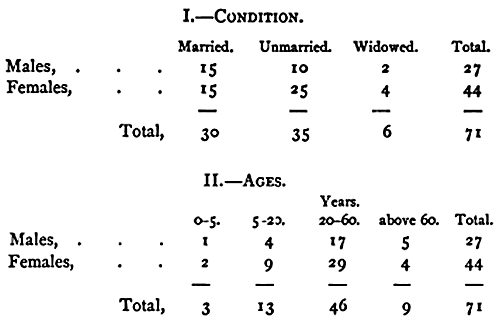
All the inhabitants of St
Kilda enumerated at the census of 1861 were natives of the island except
two,—viz., Mr Kennedy, the catechist and registrar, who was born at
Ardchattan, Argyllshire; and poor Betty Scott — who perished with the
“Dargavel” in 1863—wife of one of the M‘Donalds, and mother of the belle
of the island, already referred to, whose birthplace was Lochinver, in
the county of Sutherland. Mr Morgan describes her as “the Mrs Poyser of
the village—smart, energetic, talkative and shrewd”—and appears to have
been equally impressed with her pretty, fair-haired daughter, and her
“firmly-knit, frank-looking son”—a lad of seventeen or eighteen
summers—whose elastic step, and cool, daring expression of eye, induced
that gentleman to single him out as one of the boldest cragsmen in St
Kilda. Such was the Duke of Athole’s admiration of these two young
islanders, that he seriously proposed to transplant them, along with
their vigorous mother, to his Perthshire estate.
In 1871, all the
inhabitants were natives of the island except Mr M'Kay, the minister,
and his sister (since deceased)—who were respectively born in the town
of Inverness, and at Jean town in Ross-shire—and Isabella Munro,
daughter of a surveyor in Glasgow and wife of Neil M'Donald, afterwards
referred to. |

